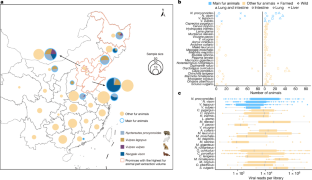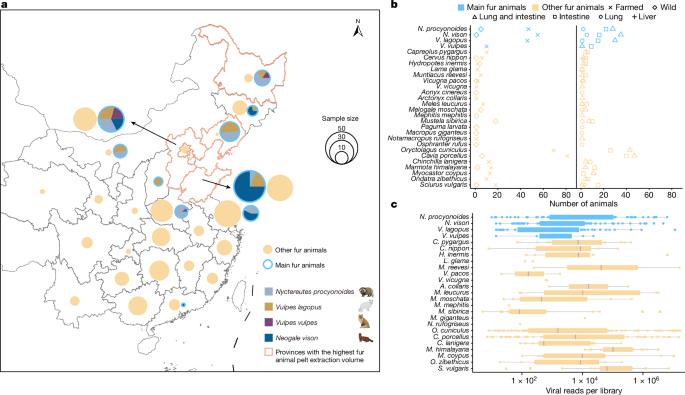Farmed fur animals harbour viruses with zoonotic spillover potential
IF 50.5
1区 综合性期刊
Q1 MULTIDISCIPLINARY SCIENCES
引用次数: 0
Abstract
Animals such as raccoon dogs, mink and muskrats are farmed for fur and are sometimes used as food or medicinal products1,2, yet they are also potential reservoirs of emerging pathogens3. Here we performed single-sample metatranscriptomic sequencing of internal tissues from 461 individual fur animals that were found dead due to disease. We characterized 125 virus species, including 36 that were novel and 39 at potentially high risk of cross-species transmission, including zoonotic spillover. Notably, we identified seven species of coronaviruses, expanding their known host range, and documented the cross-species transmission of a novel canine respiratory coronavirus to raccoon dogs and of bat HKU5-like coronaviruses to mink, present at a high abundance in lung tissues. Three subtypes of influenza A virus—H1N2, H5N6 and H6N2—were detected in the lungs of guinea pig, mink and muskrat, respectively. Multiple known zoonotic viruses, such as Japanese encephalitis virus and mammalian orthoreovirus4,5, were detected in guinea pigs. Raccoon dogs and mink carried the highest number of potentially high-risk viruses, while viruses from the Coronaviridae, Paramyxoviridae and Sedoreoviridae families commonly infected multiple hosts. These data also reveal potential virus transmission between farmed animals and wild animals, and from humans to farmed animals, indicating that fur farming represents an important transmission hub for viral zoonoses. Fur farming represents an important hub of cross-species transmission for viral zoonoses.


养殖的毛皮动物携带有可能蔓延到人畜共患病的病毒。
貉犬、水貂和麝鼠等动物因皮毛而被养殖,有时还被用作食物或药用产品1,2,但它们也是新病原体的潜在贮藏地3。在这里,我们对 461 只因病死亡的毛皮动物的体内组织进行了单样本元转录组测序。我们对 125 种病毒进行了鉴定,其中包括 36 种新型病毒和 39 种具有跨物种传播(包括人畜共患病传播)潜在高风险的病毒。值得注意的是,我们发现了 7 种冠状病毒,扩大了它们的已知宿主范围,并记录了一种新型犬呼吸道冠状病毒在浣熊犬中的跨物种传播,以及蝙蝠 HKU5 样冠状病毒在水貂中的跨物种传播,这种病毒在肺组织中含量很高。在豚鼠、水貂和麝鼠的肺部分别检测到三种亚型的甲型流感病毒--H1N2、H5N6 和 H6N2。在豚鼠体内检测到多种已知的人畜共患病病毒,如日本脑炎病毒和哺乳动物正交病毒4,5。浣熊犬和水貂携带的潜在高危病毒数量最多,而冠状病毒科、副粘病毒科和Sedoreoviridae科的病毒通常会感染多个宿主。这些数据还揭示了病毒在养殖动物和野生动物之间以及从人类到养殖动物之间的潜在传播途径,表明毛皮养殖业是病毒性人畜共患病的重要传播中心。
本文章由计算机程序翻译,如有差异,请以英文原文为准。
求助全文
约1分钟内获得全文
求助全文
来源期刊

Nature
综合性期刊-综合性期刊
CiteScore
90.00
自引率
1.20%
发文量
3652
审稿时长
3 months
期刊介绍:
Nature is a prestigious international journal that publishes peer-reviewed research in various scientific and technological fields. The selection of articles is based on criteria such as originality, importance, interdisciplinary relevance, timeliness, accessibility, elegance, and surprising conclusions. In addition to showcasing significant scientific advances, Nature delivers rapid, authoritative, insightful news, and interpretation of current and upcoming trends impacting science, scientists, and the broader public. The journal serves a dual purpose: firstly, to promptly share noteworthy scientific advances and foster discussions among scientists, and secondly, to ensure the swift dissemination of scientific results globally, emphasizing their significance for knowledge, culture, and daily life.
 求助内容:
求助内容: 应助结果提醒方式:
应助结果提醒方式:


